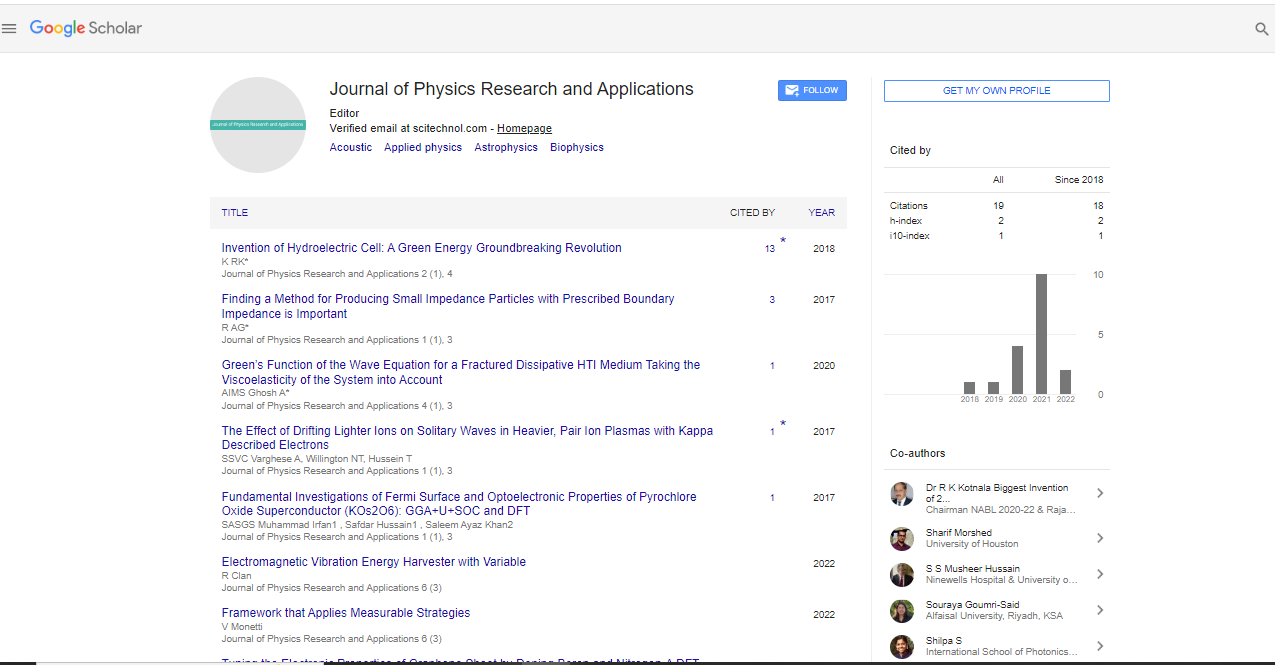Opinion Article, J Phys Res Appl Vol: 7 Issue: 2
Geophysics in Planetary Science: Understanding the Interior and Dynamics of Other Planets
Sabina Marco*
Department of physics, Tomsk Polytechnic University, Lenina Avenue, Tomsk, Russia
*Corresponding Author:Sabina Marco
Department of physics, Tomsk Polytechnic
University, Lenina Avenue, Tomsk, Russia;
E-mail: marcos@gmail.com
Received date: 22 May, 2023, Manuscript No. JPRA-23-105290;
Editor assigned date: 24 May, 2023, Pre QC. JPRA-23-105290(PQ);
Reviewed date: 15 June, 2023, QC No. JPRA-23-105290;
Revised date: 22 June, 2023, Manuscript No. JPRA-23-105290(R);
Published date: 29 June, 2023, DOI: 10.4172/JPRA.1000032
Citation: Marco S (2023) Geophysics in Planetary Science: Understanding the Interior and Dynamics of Other Planets. J Phys Res Appl 7:2.
Description
Geophysics plays an important role in planetary science by providing insights into the interior structure, composition, and dynamics of celestial bodies beyond Earth. By applying the principles and techniques of geophysics to other planets, moons, and asteroids, scientists can unravel the mysteries of their origins, evolution, and current conditions. This brief study explores the significance of geophysics in planetary science and how it helps us understand the interior and dynamics of other planets.
Interior structure and composition
Geophysics allows us to infer the interior structure and composition of other planets by a studying their gravitational fields, seismic activities, and magnetic fields. For instance, measuring the strength and variations in a planet's gravitational field can provide information about its density distribution and the presence of subsurface features such as mountains, basins, or even hidden oceans. Seismic activities, similar to earthquakes on Earth, help scientists estimate the planet's internal composition, including the presence of a solid core, mantle, and crust. Magnetic field measurements aid in understanding the planet's dynamo processes and the properties of its core.
Planetary dynamics and tectonics
Geophysical observations and models allow us to study the dynamics and tectonic activities of other planets. By analyzing surface features, such as mountains, valleys, and rift systems, scientists can infer the past and present tectonic processes that shape the planetary crust. Studying the patterns of volcanism and identifying lava flows provide insights into the planet's volcanic activity and its thermal evolution. Geophysical data also helps investigate planetary magnetic field variations, which are related to the dynamo processes occurring in the planet's core. Understanding the planetary dynamics and tectonics aids in deciphering the geological history and potential habitability of these celestial bodies.
Geophysical exploration techniques
To study the interior and dynamics of other planets, scientists employ various geophysical exploration techniques. Remote sensing is a primary method that involves using spacecraft and telescopes to observe planetary surfaces, measure their composition, and map their topography. Satellite-based gravity measurements provide information about the planet's mass distribution and internal structure. Seismic data, obtained from seismometers on landers or rovers, can help determine the planet's internal seismic wave velocities and infer its composition. Magnetic field measurements, utilizing magnetometers onboard spacecraft, reveal the presence of a planetary magnetic field and provide insights into its generation mechanisms.
Planetary analog studies
To better understand geophysical processes on other planets, scientists conduct analog studies on Earth. They identify terrestrial environments that mimic certain planetary conditions and study their geological features and dynamics. For example, studying lava flows and volcanic formations in Iceland can provide insights into similar processes on Mars. These analog studies help validate geophysical models, test hypotheses, and provide context for interpreting planetary data.
Implications for planetary science
Geophysics in planetary science has significant implications. It helps us understand the evolution of planetary bodies, including the formation and differentiation processes that shaped them. By studying the internal dynamics, geophysical processes, and potential habitable conditions of other planets, we gain insights into the possibilities of extraterrestrial life. Geophysical data also aids in the selection of landing sites for future missions, enabling scientists to explore specific regions of interest and optimize scientific investigations.
Conclusion
Geophysics plays a vital role in planetary science by providing valuable insights into the interior structure, composition, and dynamics of other planets. By studying gravitational fields, seismic activities, magnetic fields, and other geophysical parameters, scientists can unravel the mysteries of celestial bodies beyond Earth. The understanding of planetary interior structure, tectonic processes, and dynamics has significant implications for our knowledge of planetary evolution, habitability, and the search for life beyond our planet. Continued advancements in geophysical techniques and missions will continue to enhance our understanding of other planets and unlock new discoveries in the field of planetary science.
 Spanish
Spanish  Chinese
Chinese  Russian
Russian  German
German  French
French  Japanese
Japanese  Portuguese
Portuguese  Hindi
Hindi 
